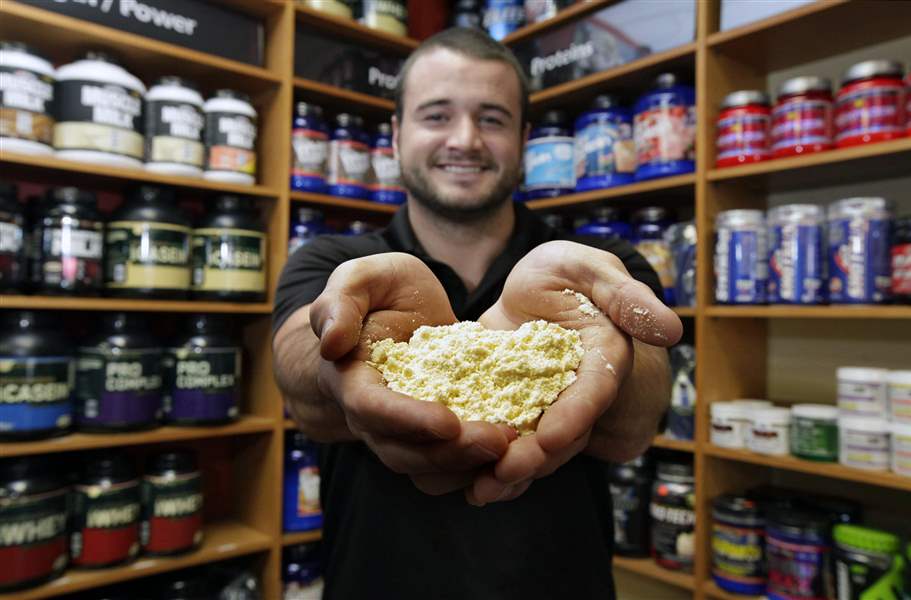
Whey’s growing role in feeding a hungry world
10/21/2012
Ryan Dorn, a sales associate at Elite Nutrition in Milwaukee, Wisconsin, holds banana-flavored whey protein. The protein-rich product is being incorporated into more food products.
Milwaukee Journal Sentinel

Ryan Dorn, a sales associate at Elite Nutrition in Milwaukee, Wisconsin, holds banana-flavored whey protein. The protein-rich product is being incorporated into more food products.
MILWAUKEE — Got whey?
From infant formula and protein supplements to sports drinks and nutrition bars, whey — the nursery rhyme food that was once a ditch-dumped byproduct of cheese making — is taking on growing clout as a global food ingredient. And food scientists are seeking even more uses for the protein-dense product that can help build muscle and lean bodies.
The Wisconsin Center for Dairy Research at the University of Wisconsin-Madison recently picked up a $1 million grant from the U.S. Department of Commerce to develop higher-value whey products for export, including new products for fast-growing Asian markets. Researchers also will be working to develop healthier dairy-based alternatives for school lunches in the United States.
Technology is helping unlock more of the nutritional value of whey as the number of mouths to feed grows across the planet.
“The technology is advancing to the point where it’s becoming even more of a valuable product for the dairy industry than it was even five years ago,” said Jen Pino-Gallagher, agricultural market development manager for the Wisconsin agriculture department.
The value comes from separating the protein in whey from its less valuable lactose, minerals, and fat.
Cheese is made by adding enzymes to milk, causing it to separate.
The curds that form are used to make cheese, leaving behind whey protein in the liquid part. The liquid whey is then pasteurized and typically dried into a powder.
Increasingly, cutting-edge technology isolates the protein from the liquid whey and captures it for high-value uses.
K.J. Burrington, dairy ingredient applications coordinator at the University of Wisconsin dairy research center, spends a lot of time in a laboratory figuring out new uses for whey, including its less in-demand components.
For instance, 80 percent of permeate — the lactose-mineral mix left after protein is isolated from whey — is now used for animal food. Only 20 percent goes into food for people. But recently, researchers have been working on developing permeate into a healthier alternative to salt, because it has a salty flavor.
“The reduced sodium [in permeate] was kind of a surprise,” said Burrington, who has worked on whey for 15 years. “It wasn’t really on anyone’s radar” until around 2000, she said.
Whey research at the UW center and elsewhere has evolved in the past 20 to 30 years. Whey initially was dried and sold as a relatively inexpensive protein filler in foods, and was fed to animals, said Dean Sommer, a cheese and food technologist at the Wisconsin Center for Dairy Research.
“That was before we realized the nutritional benefits and functionality of whey,” he said.
Whey protein has a clean, neutral flavor, so when it’s used in food manufacturing, it adds little or no taste, Mr. Sommer said.
“Whey proteins are the most nutritionally complete proteins known,” Mr. Sommer said. “That’s why body builders use whey proteins for muscle building and muscle repair, and recovery after strenuous exercise.”
Products with whey protein as a major source of protein list “whey protein isolate,” “whey protein concentrate” or “hydrolyzed whey protein” near the beginning of the ingredients list. Look for it in smoothies, oatmeal, soups, sauces, dips, and baked goods.
The low-carb movement of the early 2000s put protein in the spotlight to stay. But the focus has evolved.
A diabetic watching his or her glycemic index, or someone trying to lose fat while preserving muscle, may benefit from whey protein.
But harnessing whey’s benefits isn’t cheap.
“To do a whey plant is about $20 million to $40 million,” said Paul Bauer, general manager of the Ellsworth Cooperative Creamery, a 102-year-old co-op in western Wisconsin made up of nearly 500 dairy farms.
The creamery manufactures 30 million pounds of whey powder a year as a product of its cheese making and now exports 20 percent to 30 percent of that.
“The growing global demand for whey products is an integral part of Foremost Farms’ business,” Joan Behr, director of brand management for the Wisconsin-based dairy cooperative, said in an email. Foremost Farms USA is one of the top 10 dairy co-ops in the nation, with 2,100 dairy farmer members in Wisconsin, Minnesota, Iowa, Illinois, Indiana, Michigan and Ohio generating annual revenue of about $1.4 billion.